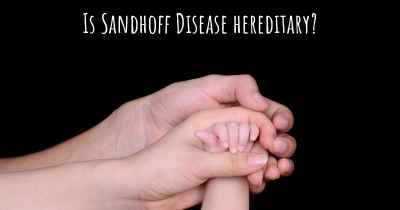What is the life expectancy of someone with Sandhoff Disease?
Life expectancy of people with Sandhoff Disease and recent progresses and researches in Sandhoff Disease

Sandhoff Disease is a rare genetic disorder characterized by the absence or malfunctioning of certain enzymes in the body. This leads to the accumulation of harmful substances in the brain and spinal cord, causing progressive neurological deterioration. Unfortunately, life expectancy for individuals with Sandhoff Disease is significantly reduced. Most affected individuals do not survive beyond early childhood, typically passing away before the age of 4. The severity and progression of symptoms can vary, but the disease is generally fatal. Currently, there is no cure for Sandhoff Disease, and treatment focuses on managing symptoms and providing supportive care to improve quality of life.
Sandhoff Disease is a rare and devastating genetic disorder that falls under the category of lysosomal storage diseases. It is an autosomal recessive disorder, meaning that both parents must carry a mutated gene for the disease to be passed on to their child. This disorder is caused by a deficiency of an enzyme called beta-hexosaminidase, which is responsible for breaking down a fatty substance called GM2 ganglioside. As a result, this substance accumulates in the nerve cells of the brain, leading to progressive and irreversible damage.
The prognosis for individuals with Sandhoff Disease is unfortunately very poor. The disease typically manifests in infancy or early childhood, and its progression is relentless. The severity and rate of progression can vary among affected individuals, but the disease ultimately leads to a significant decline in neurological function.
Neurological Symptoms:
The initial symptoms of Sandhoff Disease often include muscle weakness, poor muscle tone (hypotonia), and an exaggerated startle response to loud noises. As the disease progresses, affected individuals may experience seizures, difficulty swallowing (dysphagia), loss of motor skills, and an inability to communicate effectively. They may also develop an abnormal eye movement called a cherry-red spot, which can be observed during an eye examination.
Life Expectancy:
Given the progressive nature of Sandhoff Disease and the severe neurological deterioration it causes, the life expectancy for individuals with this condition is significantly reduced. Unfortunately, most individuals with Sandhoff Disease do not survive beyond early childhood. The disease typically leads to a rapid decline in health, with affected individuals experiencing a decline in cognitive function, loss of motor abilities, and increasing difficulty in breathing and swallowing.
Palliative Care and Support:
While there is currently no cure for Sandhoff Disease, supportive and palliative care can help improve the quality of life for affected individuals and their families. A multidisciplinary approach involving healthcare professionals such as neurologists, physical therapists, occupational therapists, and speech therapists can help manage symptoms and provide comfort.
Supportive measures may include medications to control seizures, feeding tubes to ensure adequate nutrition, and respiratory support to assist with breathing difficulties. Additionally, early intervention programs and educational support can help optimize the developmental potential of affected children.
Research and Future Perspectives:
Advancements in medical research are ongoing, with the aim of developing potential treatments for Sandhoff Disease. Gene therapy, enzyme replacement therapy, and other experimental approaches are being explored to address the underlying genetic and biochemical abnormalities associated with the disease. However, it is important to note that these treatments are still in the experimental stages and have not yet been proven to provide a cure or significantly alter the disease course.
Conclusion:
Sandhoff Disease is a devastating genetic disorder that severely impacts the neurological function of affected individuals. The life expectancy for individuals with Sandhoff Disease is unfortunately significantly reduced, with most affected individuals not surviving beyond early childhood. However, supportive and palliative care measures can help improve the quality of life for affected individuals and their families. Ongoing research offers hope for potential future treatments, but currently, there is no cure for this devastating disease.
Classic infantile form of the disease is classified by the development of symptoms anywhere from 2 months to 9 months of age. It is the most severe of all of the forms and will lead to death before the patient reaches the age of three. This is the most common and severe form of Sandhoff disease. Infants with this disorder typically appear normal until the age of 3 to 6 months, when development slows and muscles used for movement weaken. Affected infants lose motor skills such as turning over, sitting, and crawling. As the disease progresses, infants develop seizures, vision and hearing loss, dementia, and paralysis. An eye abnormality called a cherry-red spot, which can be identified with an eye examination, is characteristic of this disorder. Some infants with Sandhoff disease may have enlarged organs or bone abnormalities. Children with the severe form of this disorder usually live only into early childhood.
Juvenile form of the disease shows symptoms starting at age 3 ranging to age 10 and, although the child usually dies by the time they are 15, it is possible for them to live longer if they are under constant care. Symptoms include autism, ataxia, motor skills regression, spacticity, and learning disorders.
Adult onset form of the disease is classified by its occurrence in older individuals and has an effect on the motor function of these individuals. It is not yet known if Sandhoff disease will cause these individuals to have a decrease in their life span.
Juvenile and adult onset forms of Sandhoff disease are very rare. Signs and symptoms can begin in childhood, adolescence, or adulthood and are usually milder than those seen with the infantile form of Sandhoff disease. As in the infantile form, mental abilities and coordination are affected. Characteristic features include muscle weakness, loss of muscle coordination and other problems with movement, speech problems, and mental illness. These signs and symptoms vary widely among people with late-onset forms of Sandhoff disease.
Posted Feb 24, 2017 by Levi Christopher Lucero, Jr. 2185
Posted May 11, 2017 by Mara 700








